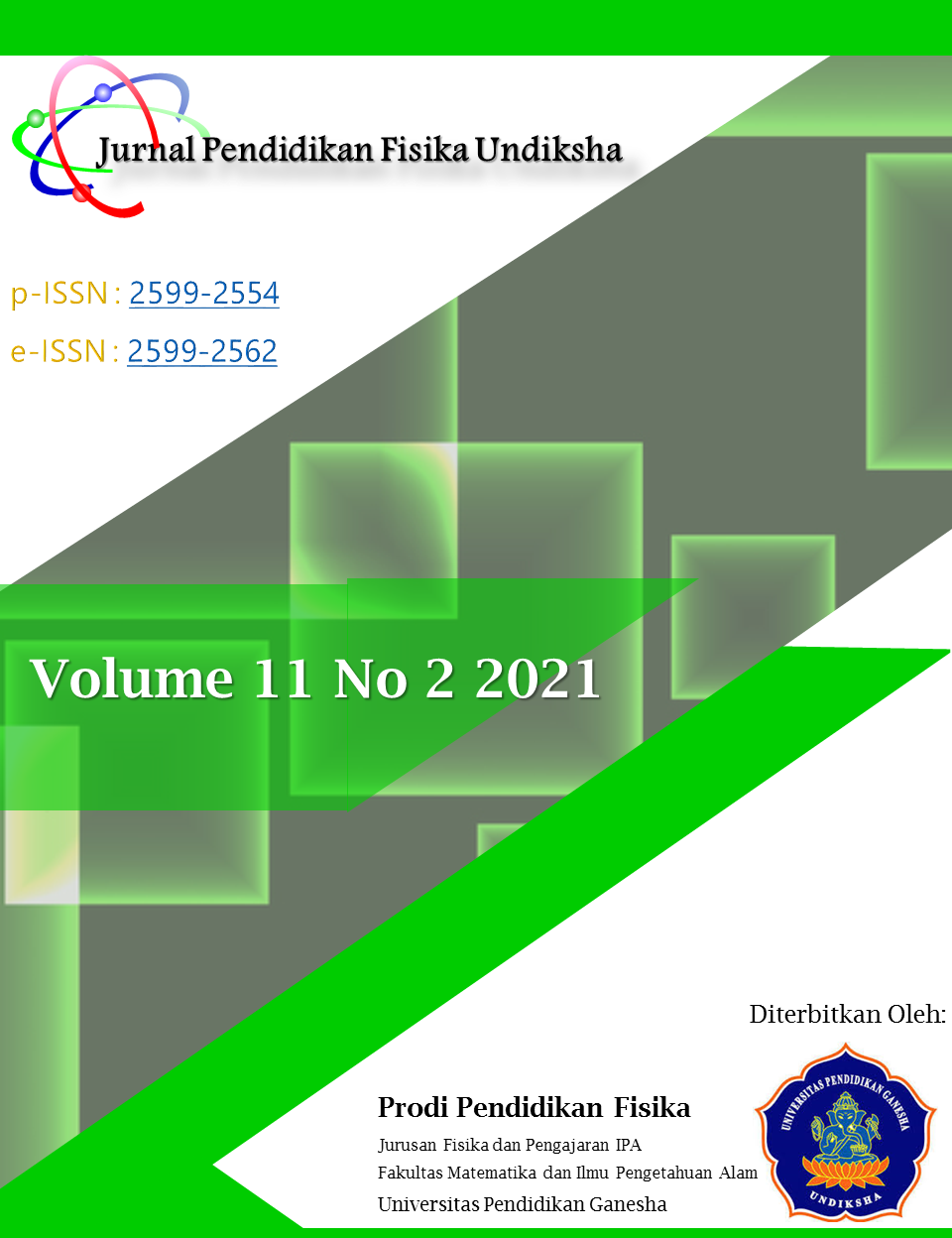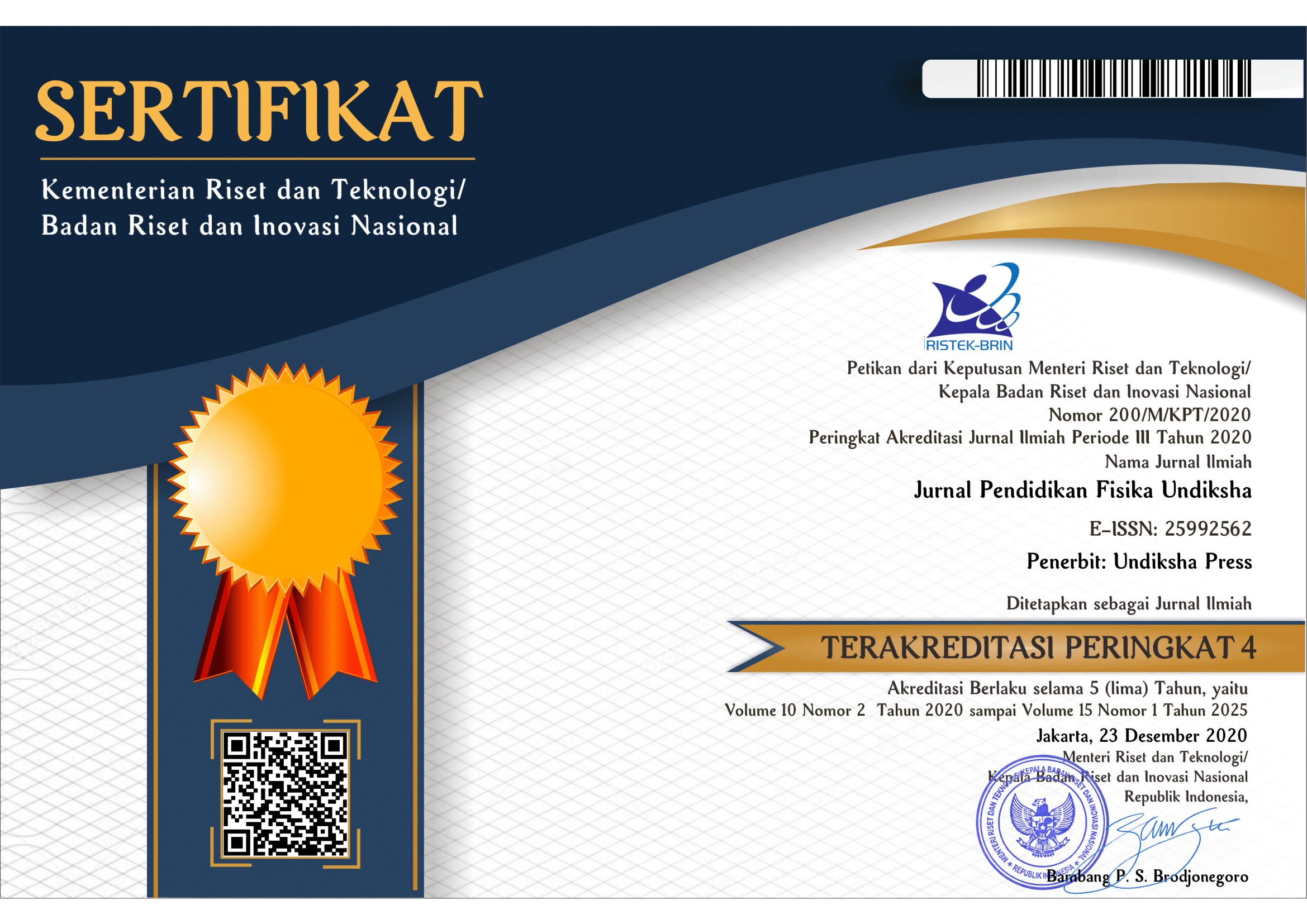PENGARUH GOOGLE CLASSROOM BERBASIS WEB DENGAN IMPLEMENTASI MODEL PROJECT BASED LEARNING TERHADAP HASIL BELAJAR PESERTA DIDIK
DOI:
https://doi.org/10.23887/jjpf.v11i2.39286Keywords:
Google Classroom, Project Based Learning, Learning OutcomesAbstract
This study aims to determine the learning outcomes of students in the use of the web-based Google Classroom application with the implementation of a project-based learning model in physics subject matter thermodynamics. In addition, students' responses to the treatments given were also considered as material for the evaluation of researchers. The research method applied is quantitative with a pre-experimental approach and using a one-shot case study as the research design. The place for implementation is carried out at Gorontalo 1 State Senior High School for the even semester of the 2019/2020 school year, with research subjects in class XI IPA 1, XI IPA 2, and XI IPA 8, with the number of students per class successively 30, 30, and 32. Hypostatic analysis of research data using the mean test technique with t test statistics, where hypothesis testing will be based on the KKM in the research school, namely 75. Based on the results of hypothesis testing, it is known that the t value for each class is 7.27, 3.44, and 4.17, which greater than the price of the t table which is 1.69 (thit> ttab), then the applicable statistical hypothesis is that H0 is accepted and Ha is rejected for all research classes, where H0 states that student learning outcomes are at least 75 with good predicate (B ).
References
Dantes, Nyoman. 2012. Metode Penelitian. Yogyakarta. Andi Offset
H. D. Young dan R. A. Freedman. 2002. Fisika Universitas Edisi Kesepuluh Jilid I. Jakarta: Erlangga
Kementerian Pendidikan dan Kebudayaan (Kemendikbud). (2016). Panduan Penilaian Oleh Pendidik dan Satuan Pendidikan Untuk Sekolah Menengah Pertama. Jakarta: Direktorat Jenderal Pendidikan Dasar dan Menengah, Direktorat Pembinaan Sekolah Menengah Pertama
Na’imah, Nur Jannatu & Supartono dan Sri Wardani. (2015). Penerapan Pembelajaran Berbasis Proyek Berbantuan E-Learning Untuk Meningkatkan Hasil Belajar Siswa.Jurnal Inovasi Pendidikan Kimia. Vol 9.No. 2.
Nofitri et al. (2013). Pembuktian Hukum Boyle pada Gas Ideal Berbantuan Data Studio Software dalam Praktikum Termodinamika. Prosiding Simposium Nasional Inovasi dan Pembelajaran Sains. Bandung
Pradana, Diemas Bagas Panca dan Rina Harimurti. (2017). Pengaruh Penerapan Tools Google Classroom Pada Model Pembelajaran Project Based Learning Terhadap Hasil Belajar Siswa. Jurnal IT-Edu. No 01. Vol 02
Rahmat, Abdul. 2015. Belajar dan pembelajaran. Gorontalo: Ideas Publishing
Riduwan. 2013. Metode dan Teknik Menyusun Tesis. Bandung: Alfabeta.
S. Syafriyudin. (2013). Pembangkit Listrik Tenaga Panas Matahari Berbasis Mesin Striling Untuk Skala Rumah Tangga. Jurnal Teknologi 6
Sudjana. 2005. Metode Statistika. Bandung: TARSITO
Supratiknya, A. 2012.Penialian Hasil Belajar dengan Teknik Nontes.Yogyakarta : UniversitasSanata Darma.
Suprijono, Agus. 2012. Cooperative Learning : Teori dan Aplikasi PAIKEM. Yogyakarta : Pustaka Pelajar.
Sutrisno, L., Kresnadi, H., dan Kartono. (2007). Pengembangan Pembelajaran IPA SD. Jakarta: Ditjen Dikti.
The George Lucas Educational Foundation .(2005). Instructional Module Project Based Learning. Diambil pada tanggal 24 april 2019 dari http://www. edutopia.org/modules/PBL/whatpbl.php
Wulansari. (2018) . Pengembangan Perangkat Pembelajaran Berbasis Model Pembelajaran Blended Learning Dengan Memanfaatkan Google Classroom Pada Materi Vektor Dalam Ruang Dimensi Tiga Di Kelas X Mia 4 Sma Negeri 7 Yogyakarta. Yogyakarta: Universitas Sanata Dharma.
Downloads
Published
Issue
Section
License

Jurnal Pendidikan Fisika Undiksha is licensed under a Creative Commons Attribution-ShareAlike 4.0 International License.







